TLAW 101 Business Law: Contract Law, Tenders and Communication
VerifiedAdded on 2023/06/13
|9
|2019
|207
Report
AI Summary
This TLAW 101 Business Law assignment provides a comprehensive analysis of contract law principles in the context of tenders and communication. The first part examines the formation of contracts based on three different tenders submitted to the University of Millennia, concluding that a contract was only formed and subsequently breached with Plant Forever. The second part analyzes the legal effects of communications during the first ten days of October, determining that a contract was formed on October 10th between Famous Footwear and James. The analysis applies relevant legal rules and case laws, such as Byrne v Van Tienhoven and Partridge v Critenden, to support its conclusions. The document references various sources to substantiate its arguments and findings. Desklib offers a wide array of similar solved assignments and past papers for students.
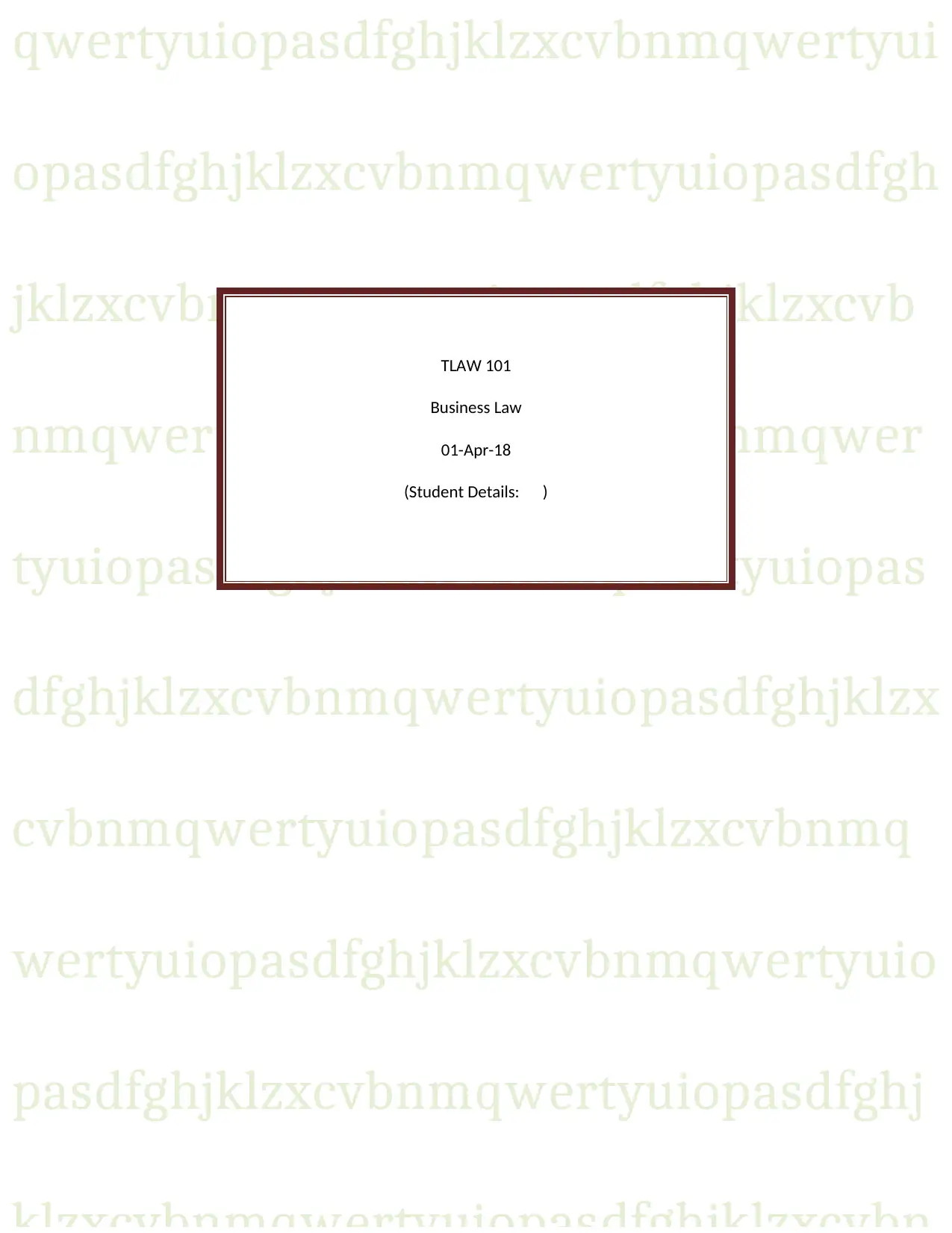
qwertyuiopasdfghjklzxcvbnmqwertyui
opasdfghjklzxcvbnmqwertyuiopasdfgh
jklzxcvbnmqwertyuiopasdfghjklzxcvb
nmqwertyuiopasdfghjklzxcvbnmqwer
tyuiopasdfghjklzxcvbnmqwertyuiopas
dfghjklzxcvbnmqwertyuiopasdfghjklzx
cvbnmqwertyuiopasdfghjklzxcvbnmq
wertyuiopasdfghjklzxcvbnmqwertyuio
pasdfghjklzxcvbnmqwertyuiopasdfghj
TLAW 101
Business Law
01-Apr-18
(Student Details: )
opasdfghjklzxcvbnmqwertyuiopasdfgh
jklzxcvbnmqwertyuiopasdfghjklzxcvb
nmqwertyuiopasdfghjklzxcvbnmqwer
tyuiopasdfghjklzxcvbnmqwertyuiopas
dfghjklzxcvbnmqwertyuiopasdfghjklzx
cvbnmqwertyuiopasdfghjklzxcvbnmq
wertyuiopasdfghjklzxcvbnmqwertyuio
pasdfghjklzxcvbnmqwertyuiopasdfghj
TLAW 101
Business Law
01-Apr-18
(Student Details: )
Paraphrase This Document
Need a fresh take? Get an instant paraphrase of this document with our AI Paraphraser

TLAW 101
Part 1
I: Issue
The facts of this case highlight the key issue in this matter as contractual relations being created
based on the three tenders.
R: Rule
A promise which has legal validity in the eyes of law, due to the presence of different elements
in the agreement, is deemed as a contract. It is basically a promise of doing something and
paying for the work being done (Gibson and Fraser, 2013). The elements which are necessary for
creating a contract include offer, acceptance, consideration, intention, consent, clarity and
capacity. In case these elements are not present, a contract would not have its legal validity
(Ayres and Klass, 2012).
The first step which has to be taken in order to create a contract is for the presence of an offer.
This offer is the terms which offering party offers to another party and have to clearly provide
what is being offered (Blum, 2007). It is of importance that the offer is differentiated from an
invitation to treat. When it comes to tenders, it is considered as an invitation to treat, because the
invitation is asked for prices, which when is accepted, results in an offer, which could become a
contract (Lindgren, 2011).
When it comes to contract formation, the next step is for an acceptance to be given to the offer
which has been made. The offer has to be accepted by the accepting party in the exact manner in
which the offer had been made. There is a need for the acceptance to be properly communicated
since mere mental decision is not consideration as valid acceptance. Under acceptance, the
Page 2
Part 1
I: Issue
The facts of this case highlight the key issue in this matter as contractual relations being created
based on the three tenders.
R: Rule
A promise which has legal validity in the eyes of law, due to the presence of different elements
in the agreement, is deemed as a contract. It is basically a promise of doing something and
paying for the work being done (Gibson and Fraser, 2013). The elements which are necessary for
creating a contract include offer, acceptance, consideration, intention, consent, clarity and
capacity. In case these elements are not present, a contract would not have its legal validity
(Ayres and Klass, 2012).
The first step which has to be taken in order to create a contract is for the presence of an offer.
This offer is the terms which offering party offers to another party and have to clearly provide
what is being offered (Blum, 2007). It is of importance that the offer is differentiated from an
invitation to treat. When it comes to tenders, it is considered as an invitation to treat, because the
invitation is asked for prices, which when is accepted, results in an offer, which could become a
contract (Lindgren, 2011).
When it comes to contract formation, the next step is for an acceptance to be given to the offer
which has been made. The offer has to be accepted by the accepting party in the exact manner in
which the offer had been made. There is a need for the acceptance to be properly communicated
since mere mental decision is not consideration as valid acceptance. Under acceptance, the
Page 2
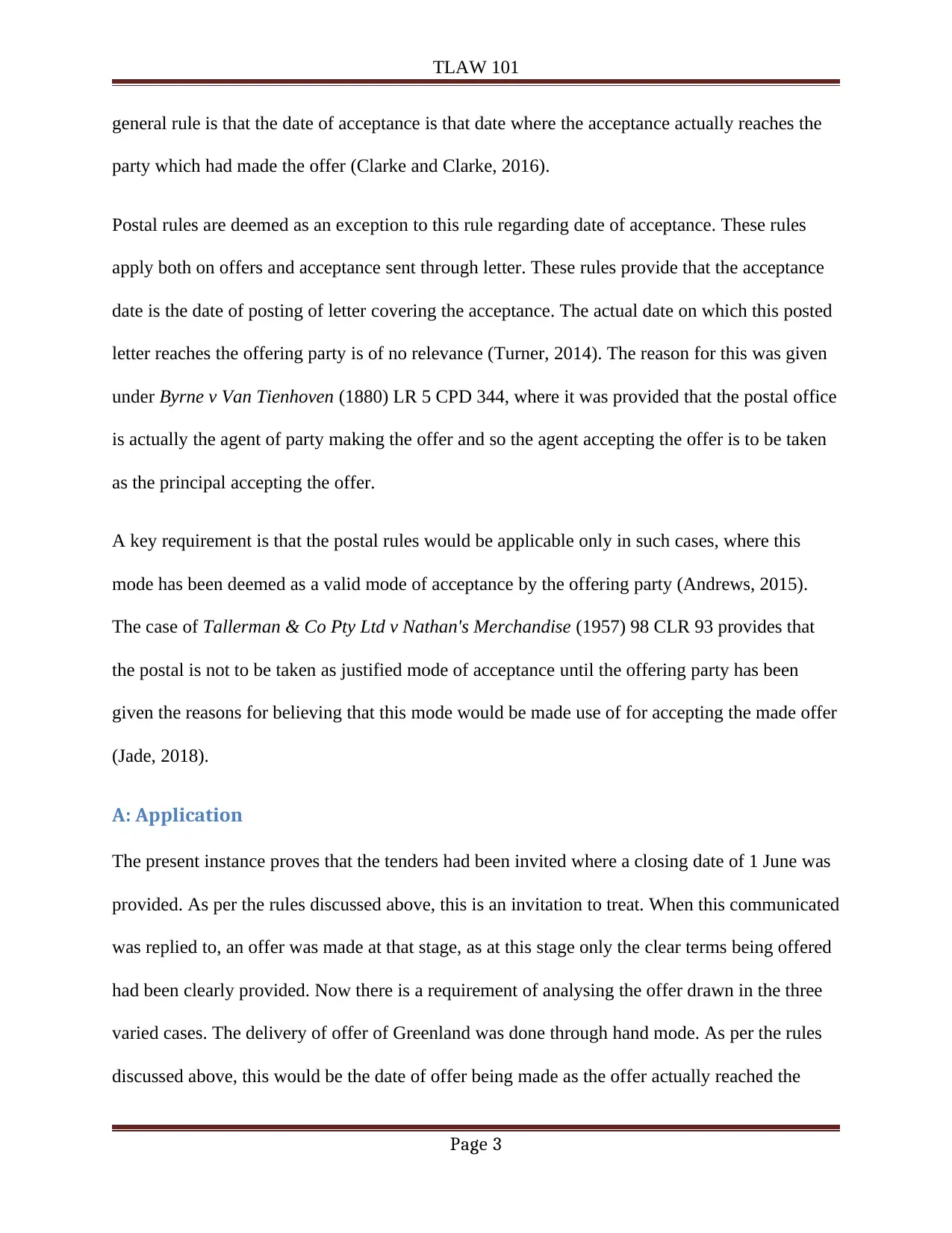
TLAW 101
general rule is that the date of acceptance is that date where the acceptance actually reaches the
party which had made the offer (Clarke and Clarke, 2016).
Postal rules are deemed as an exception to this rule regarding date of acceptance. These rules
apply both on offers and acceptance sent through letter. These rules provide that the acceptance
date is the date of posting of letter covering the acceptance. The actual date on which this posted
letter reaches the offering party is of no relevance (Turner, 2014). The reason for this was given
under Byrne v Van Tienhoven (1880) LR 5 CPD 344, where it was provided that the postal office
is actually the agent of party making the offer and so the agent accepting the offer is to be taken
as the principal accepting the offer.
A key requirement is that the postal rules would be applicable only in such cases, where this
mode has been deemed as a valid mode of acceptance by the offering party (Andrews, 2015).
The case of Tallerman & Co Pty Ltd v Nathan's Merchandise (1957) 98 CLR 93 provides that
the postal is not to be taken as justified mode of acceptance until the offering party has been
given the reasons for believing that this mode would be made use of for accepting the made offer
(Jade, 2018).
A: Application
The present instance proves that the tenders had been invited where a closing date of 1 June was
provided. As per the rules discussed above, this is an invitation to treat. When this communicated
was replied to, an offer was made at that stage, as at this stage only the clear terms being offered
had been clearly provided. Now there is a requirement of analysing the offer drawn in the three
varied cases. The delivery of offer of Greenland was done through hand mode. As per the rules
discussed above, this would be the date of offer being made as the offer actually reached the
Page 3
general rule is that the date of acceptance is that date where the acceptance actually reaches the
party which had made the offer (Clarke and Clarke, 2016).
Postal rules are deemed as an exception to this rule regarding date of acceptance. These rules
apply both on offers and acceptance sent through letter. These rules provide that the acceptance
date is the date of posting of letter covering the acceptance. The actual date on which this posted
letter reaches the offering party is of no relevance (Turner, 2014). The reason for this was given
under Byrne v Van Tienhoven (1880) LR 5 CPD 344, where it was provided that the postal office
is actually the agent of party making the offer and so the agent accepting the offer is to be taken
as the principal accepting the offer.
A key requirement is that the postal rules would be applicable only in such cases, where this
mode has been deemed as a valid mode of acceptance by the offering party (Andrews, 2015).
The case of Tallerman & Co Pty Ltd v Nathan's Merchandise (1957) 98 CLR 93 provides that
the postal is not to be taken as justified mode of acceptance until the offering party has been
given the reasons for believing that this mode would be made use of for accepting the made offer
(Jade, 2018).
A: Application
The present instance proves that the tenders had been invited where a closing date of 1 June was
provided. As per the rules discussed above, this is an invitation to treat. When this communicated
was replied to, an offer was made at that stage, as at this stage only the clear terms being offered
had been clearly provided. Now there is a requirement of analysing the offer drawn in the three
varied cases. The delivery of offer of Greenland was done through hand mode. As per the rules
discussed above, this would be the date of offer being made as the offer actually reached the
Page 3
⊘ This is a preview!⊘
Do you want full access?
Subscribe today to unlock all pages.

Trusted by 1+ million students worldwide

TLAW 101
party on that date, i.e. 29 March. When it comes to the party Enviro, this offer had been sent
through postal mode and so there is a need to apply postal rules. 15 May would be deemed as the
offering date here. Lastly, in the matter of Plan Forever, the posting of offer was on 30 May,
making it as the offering date.
In order to decide on the position of each party, there is a need to analyse the acceptance of
offers by University. For the matter of Enviro, the administrative assistant had forgotten
regarding the tender having being submitted by Enviro and this is to be deemed as the error on
part of University. As a result of this error, a contract was not created in between the two. When
it comes to the rumours regarding the reliability of Greenland, the offer was not taken into
consideration. This does not result in the law being contravened as the parties are free to accept
or ignore any offer.
In case of Plant Forever offer, this was accepted by University and post was used as the mode of
communicating acceptance. Applying Tallerman & Co Pty Ltd v Nathan's Merchandise, there
were reasons before Plant Forever to accept the post as mode of acceptance since this mode had
been used to make the offer. Applying Byrne v Van Tienhoven, the postal officer is Plant
Forever’s agent and where the post was destructed by the agent, the University cannot be
blamed. This led to a breach of contract by Plant Forever.
C: Conclusion
Hence, it can be concluded that there had been no contract formation of University with Enviro
and Greenland. A contract was only formed between University and Plant Forever, which was
breached by the latter, giving the former the right of suing for damages.
Page 4
party on that date, i.e. 29 March. When it comes to the party Enviro, this offer had been sent
through postal mode and so there is a need to apply postal rules. 15 May would be deemed as the
offering date here. Lastly, in the matter of Plan Forever, the posting of offer was on 30 May,
making it as the offering date.
In order to decide on the position of each party, there is a need to analyse the acceptance of
offers by University. For the matter of Enviro, the administrative assistant had forgotten
regarding the tender having being submitted by Enviro and this is to be deemed as the error on
part of University. As a result of this error, a contract was not created in between the two. When
it comes to the rumours regarding the reliability of Greenland, the offer was not taken into
consideration. This does not result in the law being contravened as the parties are free to accept
or ignore any offer.
In case of Plant Forever offer, this was accepted by University and post was used as the mode of
communicating acceptance. Applying Tallerman & Co Pty Ltd v Nathan's Merchandise, there
were reasons before Plant Forever to accept the post as mode of acceptance since this mode had
been used to make the offer. Applying Byrne v Van Tienhoven, the postal officer is Plant
Forever’s agent and where the post was destructed by the agent, the University cannot be
blamed. This led to a breach of contract by Plant Forever.
C: Conclusion
Hence, it can be concluded that there had been no contract formation of University with Enviro
and Greenland. A contract was only formed between University and Plant Forever, which was
breached by the latter, giving the former the right of suing for damages.
Page 4
Paraphrase This Document
Need a fresh take? Get an instant paraphrase of this document with our AI Paraphraser
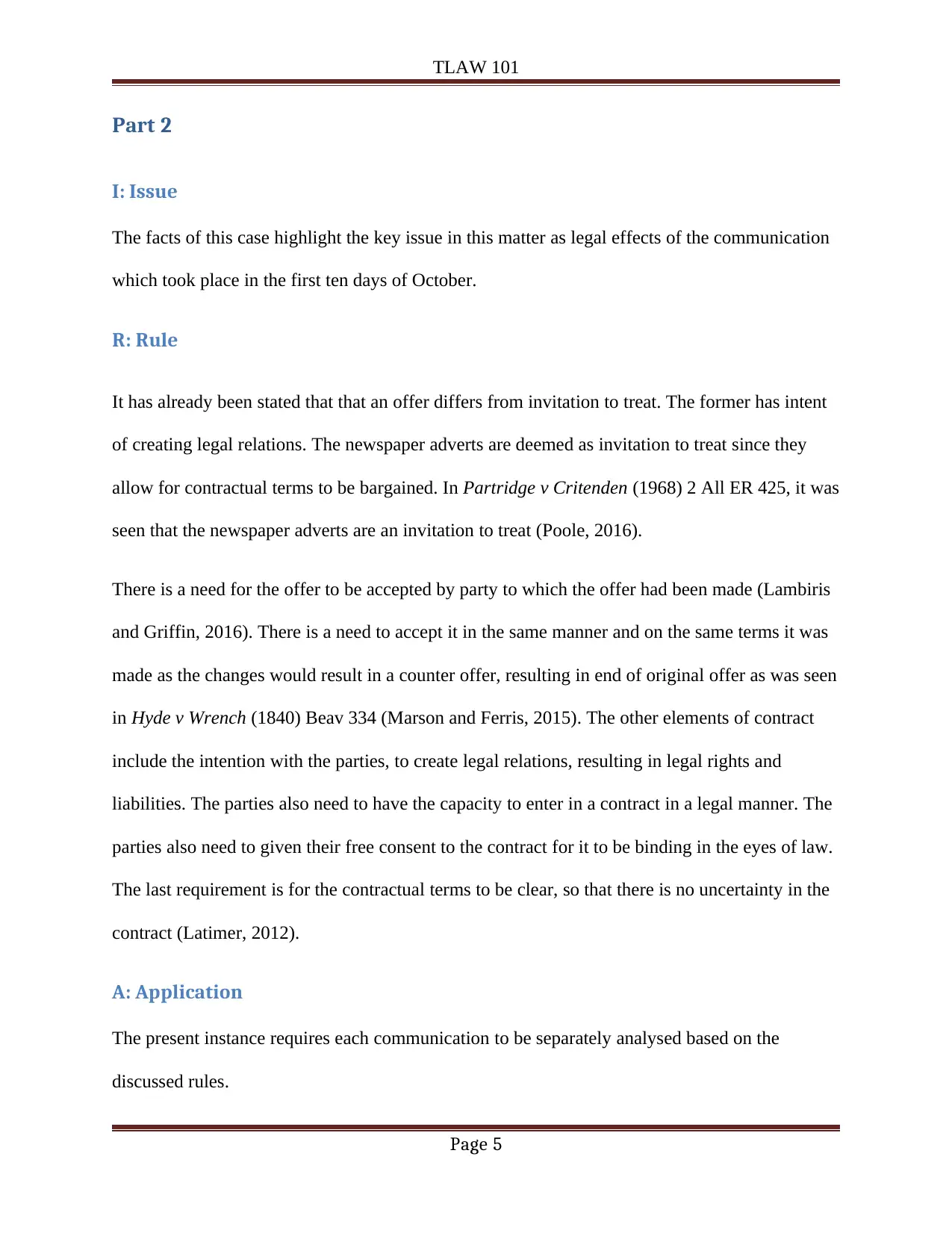
TLAW 101
Part 2
I: Issue
The facts of this case highlight the key issue in this matter as legal effects of the communication
which took place in the first ten days of October.
R: Rule
It has already been stated that that an offer differs from invitation to treat. The former has intent
of creating legal relations. The newspaper adverts are deemed as invitation to treat since they
allow for contractual terms to be bargained. In Partridge v Critenden (1968) 2 All ER 425, it was
seen that the newspaper adverts are an invitation to treat (Poole, 2016).
There is a need for the offer to be accepted by party to which the offer had been made (Lambiris
and Griffin, 2016). There is a need to accept it in the same manner and on the same terms it was
made as the changes would result in a counter offer, resulting in end of original offer as was seen
in Hyde v Wrench (1840) Beav 334 (Marson and Ferris, 2015). The other elements of contract
include the intention with the parties, to create legal relations, resulting in legal rights and
liabilities. The parties also need to have the capacity to enter in a contract in a legal manner. The
parties also need to given their free consent to the contract for it to be binding in the eyes of law.
The last requirement is for the contractual terms to be clear, so that there is no uncertainty in the
contract (Latimer, 2012).
A: Application
The present instance requires each communication to be separately analysed based on the
discussed rules.
Page 5
Part 2
I: Issue
The facts of this case highlight the key issue in this matter as legal effects of the communication
which took place in the first ten days of October.
R: Rule
It has already been stated that that an offer differs from invitation to treat. The former has intent
of creating legal relations. The newspaper adverts are deemed as invitation to treat since they
allow for contractual terms to be bargained. In Partridge v Critenden (1968) 2 All ER 425, it was
seen that the newspaper adverts are an invitation to treat (Poole, 2016).
There is a need for the offer to be accepted by party to which the offer had been made (Lambiris
and Griffin, 2016). There is a need to accept it in the same manner and on the same terms it was
made as the changes would result in a counter offer, resulting in end of original offer as was seen
in Hyde v Wrench (1840) Beav 334 (Marson and Ferris, 2015). The other elements of contract
include the intention with the parties, to create legal relations, resulting in legal rights and
liabilities. The parties also need to have the capacity to enter in a contract in a legal manner. The
parties also need to given their free consent to the contract for it to be binding in the eyes of law.
The last requirement is for the contractual terms to be clear, so that there is no uncertainty in the
contract (Latimer, 2012).
A: Application
The present instance requires each communication to be separately analysed based on the
discussed rules.
Page 5
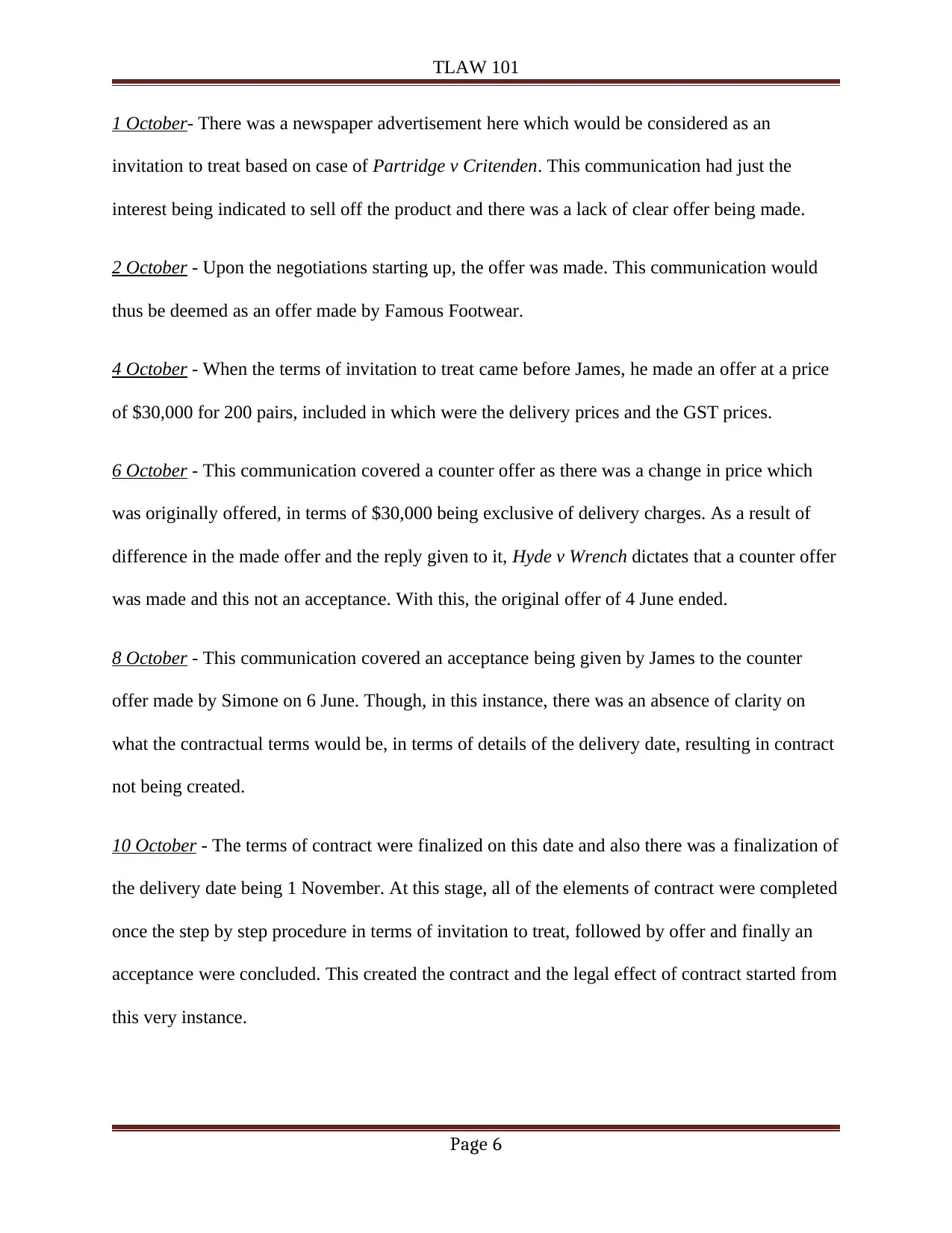
TLAW 101
1 October- There was a newspaper advertisement here which would be considered as an
invitation to treat based on case of Partridge v Critenden. This communication had just the
interest being indicated to sell off the product and there was a lack of clear offer being made.
2 October - Upon the negotiations starting up, the offer was made. This communication would
thus be deemed as an offer made by Famous Footwear.
4 October - When the terms of invitation to treat came before James, he made an offer at a price
of $30,000 for 200 pairs, included in which were the delivery prices and the GST prices.
6 October - This communication covered a counter offer as there was a change in price which
was originally offered, in terms of $30,000 being exclusive of delivery charges. As a result of
difference in the made offer and the reply given to it, Hyde v Wrench dictates that a counter offer
was made and this not an acceptance. With this, the original offer of 4 June ended.
8 October - This communication covered an acceptance being given by James to the counter
offer made by Simone on 6 June. Though, in this instance, there was an absence of clarity on
what the contractual terms would be, in terms of details of the delivery date, resulting in contract
not being created.
10 October - The terms of contract were finalized on this date and also there was a finalization of
the delivery date being 1 November. At this stage, all of the elements of contract were completed
once the step by step procedure in terms of invitation to treat, followed by offer and finally an
acceptance were concluded. This created the contract and the legal effect of contract started from
this very instance.
Page 6
1 October- There was a newspaper advertisement here which would be considered as an
invitation to treat based on case of Partridge v Critenden. This communication had just the
interest being indicated to sell off the product and there was a lack of clear offer being made.
2 October - Upon the negotiations starting up, the offer was made. This communication would
thus be deemed as an offer made by Famous Footwear.
4 October - When the terms of invitation to treat came before James, he made an offer at a price
of $30,000 for 200 pairs, included in which were the delivery prices and the GST prices.
6 October - This communication covered a counter offer as there was a change in price which
was originally offered, in terms of $30,000 being exclusive of delivery charges. As a result of
difference in the made offer and the reply given to it, Hyde v Wrench dictates that a counter offer
was made and this not an acceptance. With this, the original offer of 4 June ended.
8 October - This communication covered an acceptance being given by James to the counter
offer made by Simone on 6 June. Though, in this instance, there was an absence of clarity on
what the contractual terms would be, in terms of details of the delivery date, resulting in contract
not being created.
10 October - The terms of contract were finalized on this date and also there was a finalization of
the delivery date being 1 November. At this stage, all of the elements of contract were completed
once the step by step procedure in terms of invitation to treat, followed by offer and finally an
acceptance were concluded. This created the contract and the legal effect of contract started from
this very instance.
Page 6
⊘ This is a preview!⊘
Do you want full access?
Subscribe today to unlock all pages.

Trusted by 1+ million students worldwide

TLAW 101
C: Conclusion
Hence, it can be concluded that the contract was formed on 10 October after a number of
correspondences haven taken place between the parties in discussion.
Page 7
C: Conclusion
Hence, it can be concluded that the contract was formed on 10 October after a number of
correspondences haven taken place between the parties in discussion.
Page 7
Paraphrase This Document
Need a fresh take? Get an instant paraphrase of this document with our AI Paraphraser
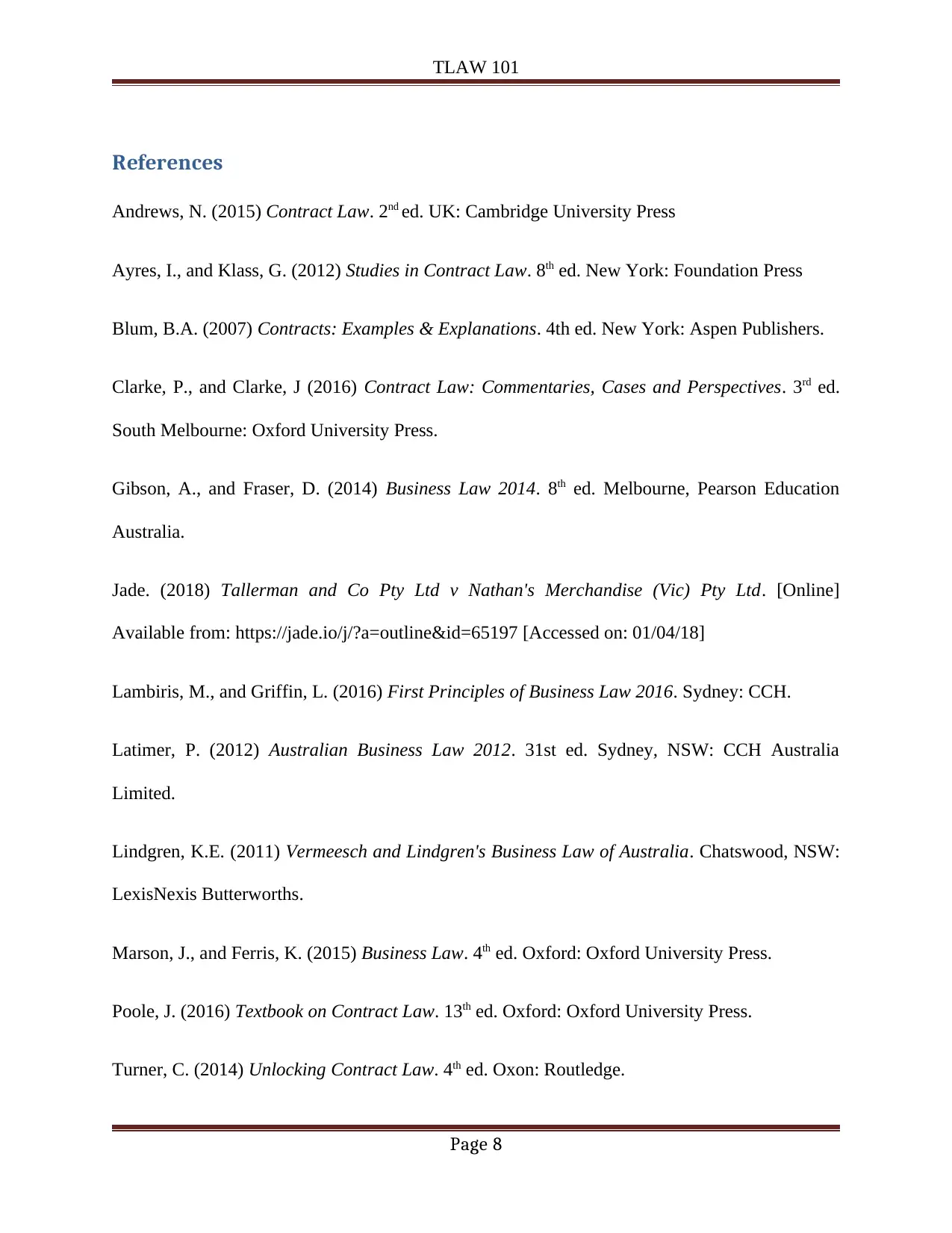
TLAW 101
References
Andrews, N. (2015) Contract Law. 2nd ed. UK: Cambridge University Press
Ayres, I., and Klass, G. (2012) Studies in Contract Law. 8th ed. New York: Foundation Press
Blum, B.A. (2007) Contracts: Examples & Explanations. 4th ed. New York: Aspen Publishers.
Clarke, P., and Clarke, J (2016) Contract Law: Commentaries, Cases and Perspectives. 3rd ed.
South Melbourne: Oxford University Press.
Gibson, A., and Fraser, D. (2014) Business Law 2014. 8th ed. Melbourne, Pearson Education
Australia.
Jade. (2018) Tallerman and Co Pty Ltd v Nathan's Merchandise (Vic) Pty Ltd. [Online]
Available from: https://jade.io/j/?a=outline&id=65197 [Accessed on: 01/04/18]
Lambiris, M., and Griffin, L. (2016) First Principles of Business Law 2016. Sydney: CCH.
Latimer, P. (2012) Australian Business Law 2012. 31st ed. Sydney, NSW: CCH Australia
Limited.
Lindgren, K.E. (2011) Vermeesch and Lindgren's Business Law of Australia. Chatswood, NSW:
LexisNexis Butterworths.
Marson, J., and Ferris, K. (2015) Business Law. 4th ed. Oxford: Oxford University Press.
Poole, J. (2016) Textbook on Contract Law. 13th ed. Oxford: Oxford University Press.
Turner, C. (2014) Unlocking Contract Law. 4th ed. Oxon: Routledge.
Page 8
References
Andrews, N. (2015) Contract Law. 2nd ed. UK: Cambridge University Press
Ayres, I., and Klass, G. (2012) Studies in Contract Law. 8th ed. New York: Foundation Press
Blum, B.A. (2007) Contracts: Examples & Explanations. 4th ed. New York: Aspen Publishers.
Clarke, P., and Clarke, J (2016) Contract Law: Commentaries, Cases and Perspectives. 3rd ed.
South Melbourne: Oxford University Press.
Gibson, A., and Fraser, D. (2014) Business Law 2014. 8th ed. Melbourne, Pearson Education
Australia.
Jade. (2018) Tallerman and Co Pty Ltd v Nathan's Merchandise (Vic) Pty Ltd. [Online]
Available from: https://jade.io/j/?a=outline&id=65197 [Accessed on: 01/04/18]
Lambiris, M., and Griffin, L. (2016) First Principles of Business Law 2016. Sydney: CCH.
Latimer, P. (2012) Australian Business Law 2012. 31st ed. Sydney, NSW: CCH Australia
Limited.
Lindgren, K.E. (2011) Vermeesch and Lindgren's Business Law of Australia. Chatswood, NSW:
LexisNexis Butterworths.
Marson, J., and Ferris, K. (2015) Business Law. 4th ed. Oxford: Oxford University Press.
Poole, J. (2016) Textbook on Contract Law. 13th ed. Oxford: Oxford University Press.
Turner, C. (2014) Unlocking Contract Law. 4th ed. Oxon: Routledge.
Page 8
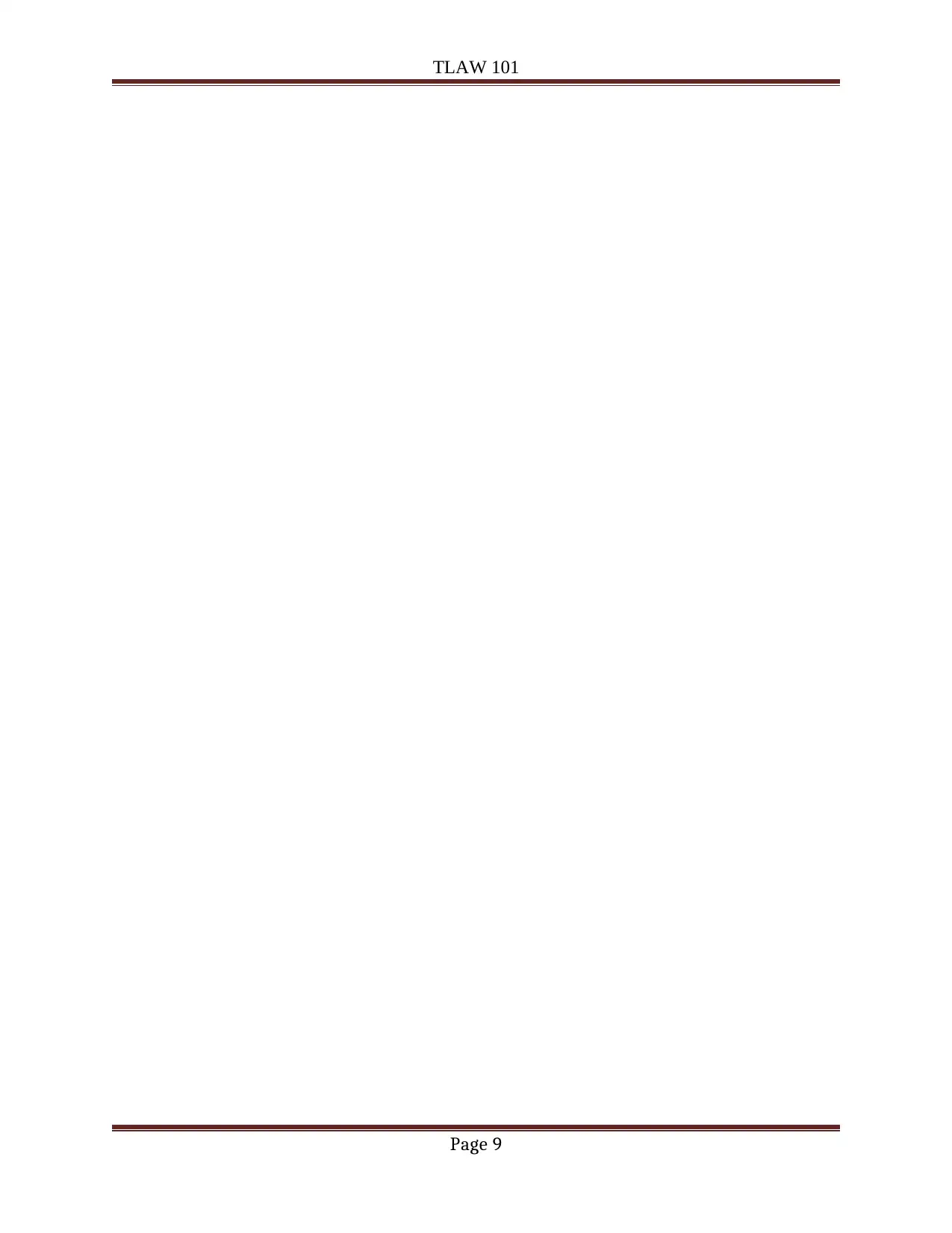
TLAW 101
Page 9
Page 9
⊘ This is a preview!⊘
Do you want full access?
Subscribe today to unlock all pages.

Trusted by 1+ million students worldwide
1 out of 9
Related Documents
Your All-in-One AI-Powered Toolkit for Academic Success.
+13062052269
info@desklib.com
Available 24*7 on WhatsApp / Email
![[object Object]](/_next/static/media/star-bottom.7253800d.svg)
Unlock your academic potential
Copyright © 2020–2025 A2Z Services. All Rights Reserved. Developed and managed by ZUCOL.





